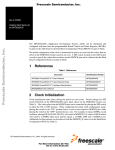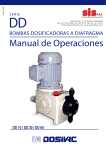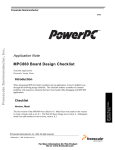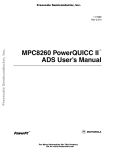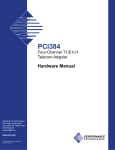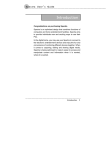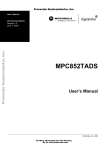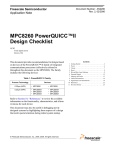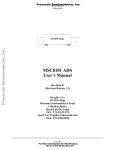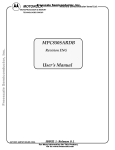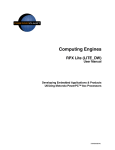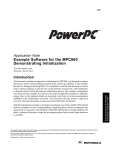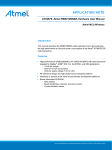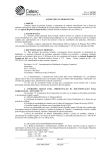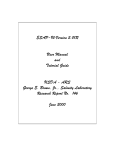Download revising code designed for the eng board to also run on the pilot board
Transcript
Order this document by AN2131 Freescale Semiconductor Freescale Semiconductor, Inc... 12/99 REV 1 Application Note MPC8260ADS - REVISING CODE DESIGNED FOR THE ENG BOARD TO ALSO RUN ON THE PILOT BOARD Netcomm Applications Freescale, Austin, Texas I. Purpose – Differences between the ENG and PILOT revisions of the MPC8260ADS board (ADS) may impact preliminary application development and Third Party Developers’BSP’s. This application note is provided as a quick template to revise code which was developed using the ENG revision but now needs to be ported to the PILOT revision of the MPC8260ADS. This note will not discuss additional features of the PILOT board, as these would not affect code which was written for the ENG board revision. For complete information on the MPC8260ADS, refer to the MPC8260ADS User’s Manual, Rev 0.213, dated November, 1999 (ADS UM) at: http://www.mot.com/netcomm. The ENG board was the first release of the board, the last of these were shipped in November, 1999. The PILOT board is the second release of the board, which began shipping at the end of November 1999. Both boards have a sticker which clearly indicates if they are ENG or PILOT. The ENG revision’s sticker is located between DS1 and LD16. The PILOT revision’s sticker is located just above the ATM port, U1. II. The Board Control and Status Registers (BCSRx) © Freescale Semiconductor, Inc., 2004. All rights reserved. The bit values of BCSR0 and BCSR1 are now located at D(0:7) on the PILOT revision. On the ENG revision, the bit values were located at D(24:31). © Freescale Semiconductor, Inc., 2004. All rights reserved. © Motorola Inc., 1998. All rights reserved. For More Information On This Product, Go to: www.freescale.com Freescale Semiconductor, Inc. BCSR0 Refer to the ADS UM, Table 4-9. The bits implemented on the ENG revision which have changed bit positions on the PILOT board are: Freescale Semiconductor, Inc... BIT SIGNAL_LAMP_0 SIGNAL_LAMP_1 ENG 30 31 PILOT 6 7 BCSR0[30,31] on the PILOT board are designated as Reserved, un-implemented. In fact, these bits are not going to become implemented, so it is safe to leave these bits toggled in PILOT board code revisions in order to allow code to be compatible for both the ENG and PILOT revisions of the ADS. However, BCSR2 now contains a Board Revision Number, which can be used to choose which BCSR0 bits to implement. See ADS UM, Table 4-11. Quickfind: Typical Location in Code These bits control the General Purpose LED0 at LD11 and the General Purpose LED1 at LD12. These LED’s are typically used to give a visual indication that a part of code is executing normally. Some applications illuminate these to indicate that packets were sent and received successfully. BCSR1 Refer to the ADS UM, Table 4-10. The bits implemented on the ENG revision which have changed bit positions on the PILOT board are: BIT ATM_EN ATM_RST FETHIEN FETH_RST RS232EN_1 RS232EN_2 ENG 26 27 28 29 30 31 PILOT 2 3 4 5 6 7 BCSR1[26-31] on the PILOT board are designated as Reserved, un-implemented. In fact, these bits are not going to become implemented, so it is safe to leave these bits toggled in PILOT board code revisions in order to allow code to be compatible for both the ENG and PILOT revisions of the ADS. However, BCSR2 now contains a Board Revision Number, which can be used to choose which BCSR1 bits to implement. See ADS UM, Table 4-11. Quickfind: Typical Location in Code ATM - The ATM_RST is used to reset the ATM phy device. The ATM_EN is used to enable the ATM phy device. These bits will typically be implemented in code which actually passes packets over the ATM phy or which demonstrate the ATM in external loopback mode. They do not affect code which only runs ATM on the MPC8260 in internal loopback mode. Fast Ethernet - The FETH_RST is used to reset the Fast Ethernet phy device. The FETHIEN is used to enable the Fast Ethernet phy device. These bits will typically be implemented in 2 For More Information On This Product, Go to: www.freescale.com Freescale Semiconductor, Inc. code which actually passes packets over the Fast Ethernet phy or which demonstrate Fast Ethernet in external loopback mode. They do not affect code which only runs Fast Ethernet on the MPC8260 in internal loopback mode. Serial Port 1 - The RS232EN_1 enables the DB9 connector at PB3. This bit is implemented in code which transmits/receives on the RS232 -1 port, such as a dumb terminal. One obvious application of this bit will be in FLASH monitor code. Freescale Semiconductor, Inc... Serial Port 2 - The RS232EN_2 enables the DB9 connector at PA3. This bit is implemented in code which transmits/receives on the RS232 -2 port, such as a dumb terminal. A possible application of this bit could be in FLASH monitor code. III. The Hard Reset Configuration Word (HRCW) The PILOT revision of the ADS is currently shipping with the processor XPC8260, revision 0.2, mask J24M. The board will be shipped with this processor until March 2000, (at which time, the board will ship with the XPC8260, revision A.1, which will not be bound by the following restriction). The only HRCW available on the PILOT board with the 0.2 processor is the one supplied by the MACH PLD at U17, which is hard coded to contain the value 0C B2 02 05. Refer to the ADS UM, Table 4-1. (And you may wish to refer also to the MPC8260 User’s Manual ((MPC8260UM/D Rev. 0)) Table 5-7). NOTE: The PILOT board is shipped with DS1-1 in the BSCR position (which is OFF), selecting the HRCW from the MACH PLD. While using the 0.2 processor, do not change this switch setting. (refer to ADS UM, section 2.3.4). The software implications of this HRCW will be application-specific, predominantly affecting code which boots up from FLASH. It is imperative that you study this HRCW value and modify your code to accept these values throughout, or change the affected register values after bootup to the values your code requires, excepting some restrictions detailed below. ENG vs PILOT board HRCW FLASH boot-up code written for and run on the ENG board does indeed use the HRCW programmed at the first locations in the FLASH module, regardless of the revision of XPC8260 processor used. This is due to the addressing of the FLASH on the ENG board, A0-A2 of the FLASH was implemented with Buffered Addresses (BA [29:27]), refer to the MPC8260ADS schematics, rev ENG, sheet 5. On the PILOT board, the addressing of the FLASH module was changed so that A0-A2 of the FLASH is now implemented with Burst Addresses (BADDR [29:27]), refer to the MPC8260ADS schematics, rev PILOT, sheet 5. However, one of the erratum of the XPC8260 rev 0.2, is that this processor does not implement the Burst Addresses during Power-On or Hard Reset. Therefore, on the PILOT board using the 0.2 processor, the FLASH will never be accessed during Power-On or Hard Reset, so regardless of the HRCW programmed into this FLASH, it will not be accessed. Chip Select 0 (CS0) during boot-up will only access the MACH PLD which will provide the HRCW values 0C B2 02 05. 3 For More Information On This Product, Go to: www.freescale.com Freescale Semiconductor, Inc. NOTE: While modifying code written for the ENG board to function on the PILOT board with the 0.2 processor, keep in mind that once the 0.2 processor is replaced with the A.1 or later revision of the processor, and DS1-1 is switched to the FLASH-booting option, the HRCW in the FLASH will be invoked. Therefore, the HRCW residing at the beginning of your FLASH code must be congruent with your code changes for future compatibility. An Example : Init8260 - Freescale Semiconductor, Inc... Probably the best way to demonstrate the affect this hard coded HRCW may have on a FLASH boot-up program is to detail what needed to be changed in our Init8260 FLASH bootup example, which will soon be available on our web page at http://www.mot.com/netcomm. The most severe restriction of the hard coded HRCW to our Init8260 FLASH boot-up code example was the Core Initial Prefix (CIP), bit 6. This bit sets the Machine State Register Initial Prefix (MSR[IP]) equal to 1, which places the system exception vector table at offset 0xFFF00000. There is no way to work around this offset, all code must accept and adjust to this value. Our code had the exception table at offset 0x00000000, which required re-linking the Init8260 boot-up example exception vector table to the offset 0xFFF00000. For some compilers, this linking to offset 0xFFF00000 for the exception vector table is not clearly documented and therefore not easily implemented. L2 Cache Pins Configuration (L2CPC) =10. This value must not be changed by the software as it configures the Burst Address Lines 29-31 (BADDR29 - BADDR31). BADDR27 BADDR29 are now used to address the FLASH, of which BADDR29 is provided by this L2CPC configuration. The cache module of our Init8260 code had independently set these bits to their cache implementation values, so this code module had to be changed to accept the value of 10. This value is necessary regardless of the revision of the processor. See the MPC8260 User’s Manual (MPC8260UM/D Rev. 0) Table 4-12. Data Parity Pins Configuration (DPPC), bits 10:11. These bits set the DPPC to the value of 11, which among other things, disables the Time Base. We use the Time Base in our Init8260 example code. Consequently, we had to modify our code to change the SIUMCR(DPPC) to the value 10 after boot-up, in order to enable the Time Base (TBEN). See the MPC8260 User’s Manual (MPC8260UM/D Rev. 0) Table 4-12. IV. The 60X SDRAM Mode Register change needed for PILOT revision. The final thing that we know to be aware of in modifying code written for the ENG board in order to make it compatible with the PILOT board, is the 60X SDRAM Mode Register - Bank Select Multiplex Address Lines (PSDMR.BSMA). The ENG revision accepted the value of 100, which selected address pins A16-A18, for bank-selecting the 60X SDRAM. The PILOT board must have this value set to 011, selecting address pins A15-A17, for bank-selecting the 60X SDRAM. The value of 011 is also acceptable to use with the ENG revision of the ADS board. This value is necessary regardless of the revision of the processor. See the MPC8260 User’s Manual (MPC8260UM/D Rev. 0) Table 10-7. 4 For More Information On This Product, Go to: www.freescale.com Freescale Semiconductor, Inc. V. Conclusion Freescale Semiconductor, Inc... Every effort was made in the design of the PILOT board to minimize the software changes necessary to run code written for the ENG revision to run on the PILOT revision of the MPC8260ADS. However, the changes to the PILOT board were necessary to provide enhanced features, such as bursting from FLASH and also to make this board recoverable in case of HRCW erasure (when is used with an XPC8260 processor such as revision A.1, which will allow booting with the HRCW programmed into FLASH). The code examples we have on the web at http://www.mot.com/netcomm have nearly all been modified to run on both the ENG and PILOT revisions of the board and are therefore specific examples for your reference. The titles of the code examples reflect which ones have been modified. How to Reach Us: Home Page: www.freescale.com E-mail: [email protected] USA/Europe or Locations Not Listed: Freescale Semiconductor Technical Information Center, CH370 1300 N. Alma School Road Chandler, Arizona 85224 +1-800-521-6274 or +1-480-768-2130 [email protected] Europe, Middle East, and Africa: Freescale Halbleiter Deutschland GmbH Technical Information Center Schatzbogen 7 81829 Muenchen, Germany +44 1296 380 456 (English) +46 8 52200080 (English) +49 89 92103 559 (German) +33 1 69 35 48 48 (French) [email protected] Japan: Freescale Semiconductor Japan Ltd. Headquarters ARCO Tower 15F 1-8-1, Shimo-Meguro, Meguro-ku, Tokyo 153-0064 Japan 0120 191014 or +81 3 5437 9125 [email protected] Asia/Pacific: Freescale Semiconductor Hong Kong Ltd. Technical Information Center 2 Dai King Street Tai Po Industrial Estate Tai Po, N.T., Hong Kong +800 2666 8080 [email protected] Information in this document is provided solely to enable system and software implementers to use Freescale Semiconductor products. There are no express or implied copyright licenses granted hereunder to design or fabricate any integrated circuits or integrated circuits based on the information in this document. Freescale Semiconductor reserves the right to make changes without further notice to any products herein. Freescale Semiconductor makes no warranty, representation or guarantee regarding the suitability of its products for any particular purpose, nor does Freescale Semiconductor assume any liability arising out of the application or use of any product or circuit, and specifically disclaims any and all liability, including without limitation consequential or incidental damages. “Typical” parameters which may be provided in Freescale Semiconductor data sheets and/or specifications can and do vary in different applications and actual performance may vary over time. All operating parameters, including “Typicals” must be validated for each customer application by customer’s technical experts. Freescale Semiconductor does not convey any license under its patent rights nor the rights of others. Freescale Semiconductor products are not designed, intended, or authorized for use as components in systems intended for surgical implant into the body, or other applications intended to support or sustain life, or for any other application in which the failure of the Freescale Semiconductor product could create a situation where personal injury or death may occur. Should Buyer purchase or use Freescale Semiconductor products for any such unintended or unauthorized application, Buyer shall indemnify and hold Freescale Semiconductor and its officers, employees, subsidiaries, affiliates, and distributors harmless against all claims, costs, damages, and expenses, and reasonable attorney fees arising out of, directly or indirectly, any claim of personal injury or death associated with such unintended or unauthorized use, even if such claim alleges that Freescale Semiconductor was negligent regarding the design or manufacture of the part. For Literature Requests Only: Freescale Semiconductor Literature Distribution Center P.O. Box 5405 Denver, Colorado 80217 1-800-441-2447 or 303-675-2140 Fax: 303-675-2150 [email protected] 5 For More Information On This Product, Go to: www.freescale.com





